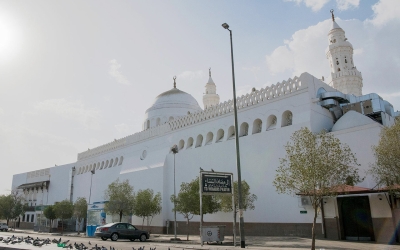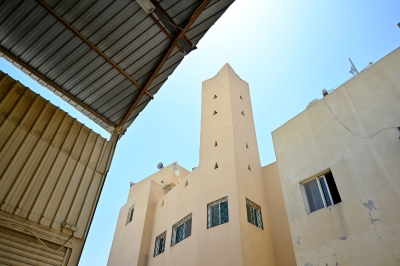Quba Mosque is the first mosque built in Islam. It was constructed in 622. It is overseen by al-Madinah Region Development Authority and is located southwest of the city of al-Madinah al-Munawwarah, on the Hijra Road. It is approximately 3.5 km away from the Prophet's Mosque.
The mosque has undergone numerous expansions and renovations since its establishment. The King Salman Expansion Project for Quba Mosque is considered the largest expansion in its history. This project was announced by the Crown Prince, Prime Minister, Chairman of the Council for Economic and Development Affairs, His Royal Highness Prince Mohammed Bin Salman Bin Abdulaziz on April 8, 2022.
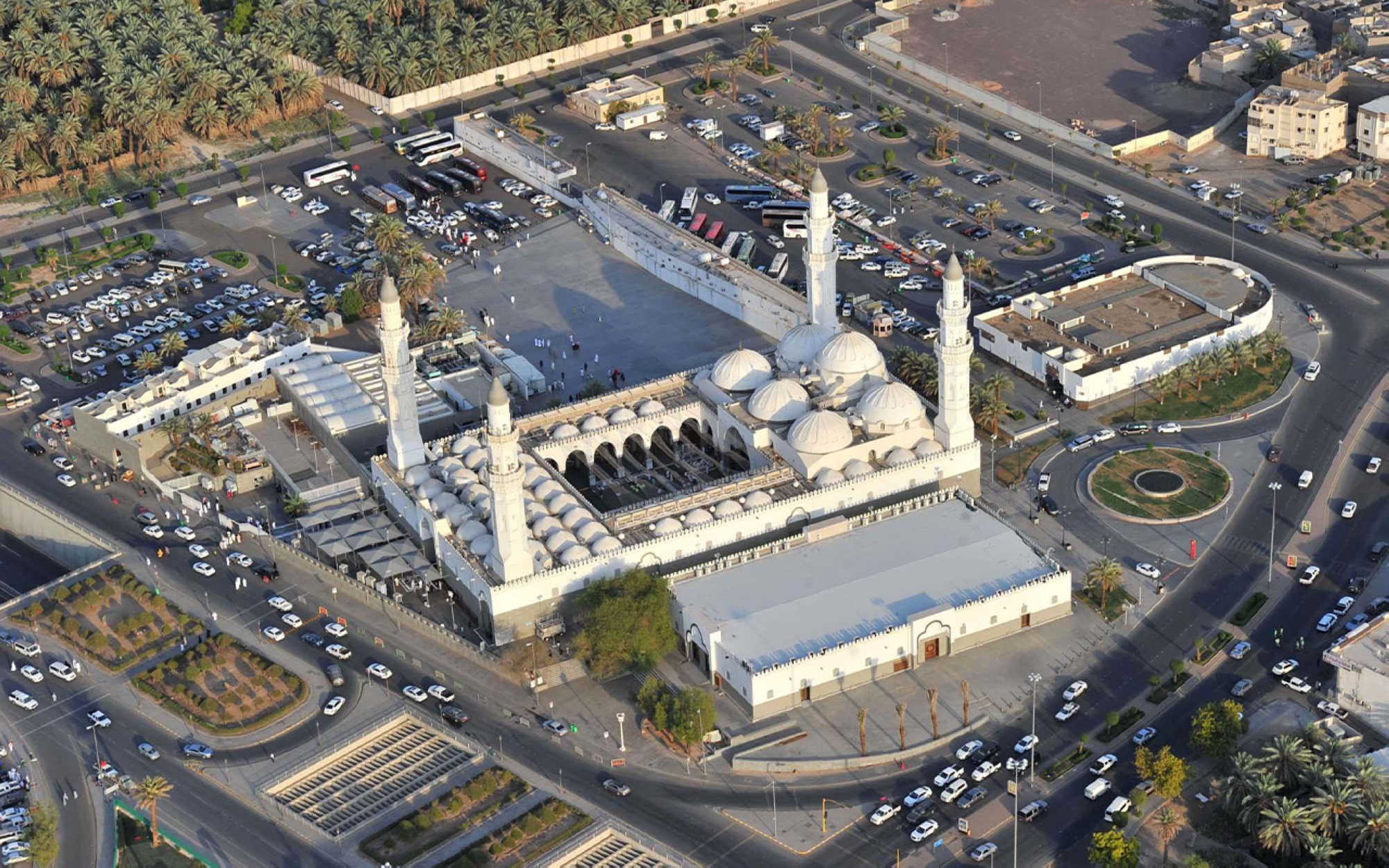
Naming of Quba Mosque
It is mentioned in Yaqut al-Hamawi's book Mu'jam al-Buldan that Quba Mosque took its name from the Quba Well that was established in that location. It was also known in ancient times as Bani Auf Mosque.
Location of Quba Mosque
Quba Mosque is located in the southwest of al-Madinah al-Munawwarah, along the Hijra Road that connects al-Madinah al-Munawwarah and Makkah al-Mukarramah. It is approximately 3.5 km away from the Prophet's Mosque. The location where the mosque was built was known in ancient times as the village of Quba. It is a village with gardens and palm trees and is situated about two or three miles away from al-Madinah al-Munawwarah.
Area of Quba Mosque
Quba Mosque is the second-largest mosque in terms of size after the Prophet's Mosque. It can accommodate twenty thousand worshipers, and the land area of the mosque is 13,500 m². The prayer hall alone covers an area of 5,035 m². It has four minarets and sixty-two domes and includes accommodations for the imams and muezzins, a library, and a shopping area to serve the visitors.
Quba Mosque in the Islamic culture
Quba Mosque holds significant importance for Muslims as it is considered the first mosque built in Islamic history. The Prophet Muhammed (PBUH) used to visit it from time to time, whether on foot or while riding, to offer prayers there, especially on Saturdays, and he used to encourage others to visit it as well. It was the first mosque where Salat al-Jumuah or Friday Prayer was established openly, and now, all prayers, including Friday Prayer and both Eids prayers, are performed there.
Imams of Quba Mosque
Several imams served at Quba Mosque since its establishment during the time of the Prophet Muhammed (PBUH) and the Rashidun Caliphs, including Salim Mawla Abi Hudhaifah, Mu'adh Ibn Jabal, Mu'adh Ibn Sa'da, and Majma' Bin Harithah. During the Saudi era, several imams served at Quba Mosque, including Ali Bin Abdulrahman al-Hudhaifi, who held the position of its imam at various times until 1979. He is the head of the scientific committee for reviewing Quran al-Madinah al-Munawwarah, and a member of the King Fahd Complex for the Printing of the Holy Quran. Among them is also Mohammed Bin Bukhait al-Hajjaily, whose appointment as the imam was made in 2023. He is a professor at the Islamic University in al-Madinah al-Munawwarah and has made several academic contributions within the Kingdom and abroad. Additionally, he has authored numerous scientific research papers and publications.
Quba Mosque design
The Saudi expansion was carried out to preserve the old design of Quba Mosque. It was constructed with four square-shaped courtyards, each side measuring forty m in length. An inner courtyard was added, along with separate sections for men and women, and the mosque was built with two floors. The mosque has multiple doors, including seven main entrances and twelve secondary entrances, allowing visitors to enter from various points.
The four courtyards are formed by a southern and a northern courtyard separated by an open space. The two courtyards are connected by two long corridors, one to the east and one to the west. Its roof features connected domes, including six large domes, each with a diameter of twelve m, and fifty-six smaller domes, with each one measuring six m in diameter. These domes are supported by arches that rest on large columns inside each courtyard.
As for the mosque's grounds and courtyard, they are covered with heat-reflective marble. The courtyard is shaded by retractable canopies made of fiberglass-reinforced fabric that can be folded and unfolded as needed. The mosque was inaugurated with this expansion in the year 1987.
Quba Mosque through the ages
Prophet Muhammed (PBUH) and his companions, may Allah be pleased with them, established Quba Mosque. It served as a place of worship and a shelter for his camel. The mosque underwent multiple renovations before the Saudi era. The first renovation was during the time of the Rashidun Caliphs when the companion Uthman Bin Affan refurbished it. Further enhancements occurred during the reign of Umar Bin Abdulaziz, who added additional structures and the first minaret between 705-712. Subsequent renovations were carried out by Abu Yaela al-Husayni in 1044, followed by Jamal al-Din al-Isfahani in 1161. It was also periodically restored by various benefactors in different years, including 1273, 1333, 1437, and 1477, and another major renovation took place in 1830.
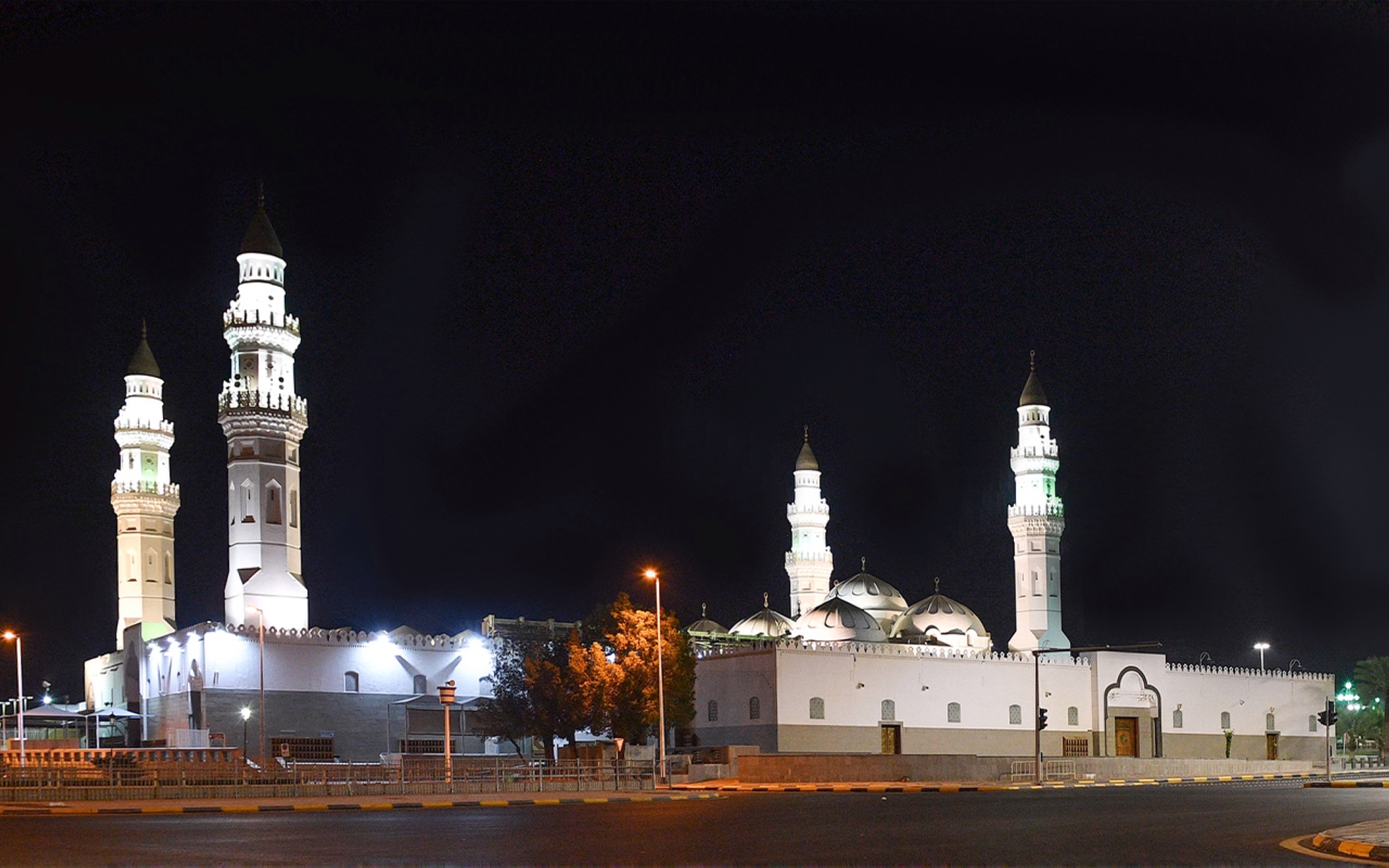
Quba Mosque during the Saudi era
Quba Mosque received attention from the Kingdom's government. Founding King Abdulaziz Al Saud ordered the construction of a straight road between the Prophet's Mosque and Quba Mosque in 1932. Furthermore, its external walls were renovated and extended to the north in 1968 during the reign of King Faisal Bin Abdulaziz.
In 1985, King Fahd Bin Abdulaziz Al Saud ordered the expansion of the mosque to nearly nine times its previous size, increasing its area from 1,600 m² to 13,500 m². This expansion included the mosque and its associated service facilities. The mosque itself covered an area of approximately 5,035 m². The order also included the reconstruction of the mosque, ensuring the preservation of its heritage elements. Pieces of the surrounding land were incorporated into the new building, which replaced the old one. The expansion included the addition of four minarets in place of the old single minaret, each minaret located on one side of the mosque, with a height of forty-seven m.
King Salman's Project to Expand Quba Mosque
King Salman's Project for the expansion of Quba Mosque is considered the largest expansion in the history of the mosque since its construction in 622. It was announced by the Crown Prince, Prime Minister, and Chairman of the Council of Economic and Development Affairs, His Royal Highness Prince Mohammed Bin Salman Bin Abdulaziz, on April 8, 2022.
King Salman's Project to Expand Quba Mosque and the development of the surrounding area aims to increase the total area of the mosque to reach fifty thousand m², which is equivalent to ten times its size before the expansion. This expansion will also increase its capacity to accommodate approximately sixty-six thousand worshipers.
The project is centered on providing shaded areas and independent prayer spaces in the courtyards surrounding the mosque. It also includes providing necessary services for the mosque, improving the infrastructure surrounding it to accommodate larger numbers of visitors easily during peak seasons and times, offering solutions for crowd management, and enhancing the safety of worshippers. Additionally, the project involves the development of several historical sites surrounding the mosque, including fifty-seven locations such as farms, gardens, and wells. This project aims to achieve the goals of Saudi Vision 2030 through the Quality of Life and Pilgrim Experience programs.
Quba Front Project
As part of the City Huminatization Program, overseen by al-Madinah Region Development Authority, the Quba Front Project was launched. It consists of a three km pathway extending from Quba Mosque to the vicinity of the Prophet's Mosque. This pathway includes various facilities designed for pedestrians, residential towers, and hotels, as well as corners and shops for selling various goods.
The project aims to attract tourists within a modern space that preserves the urban character of al-Madinah al-Munawwarah. The market area includes spaces for local producers, offering a wide range of goods, including sweets, traditional dishes, clothing, children's toys, gold, and jewelry.
This project is part of the infrastructure projects that serve the residents of al-Madinah al-Munawwarah and its visitors. It provides them with access between Quba Mosque and the Prophet's Mosque through a paved and accessible pathway, including facilities for people with disabilities, especially during the months of Ramadan and Dhul-Hijjah when more visitors come to the site.
The project included adding touches to beautify the space, as the colors of the facades of the buildings overlooking the corridors were unified, and the designs of the shops were also unified. In 2018, the front project received the award for the best tourist attraction site in the Kingdom.
Elements of Arab and Islamic heritage around Quba Mosque.
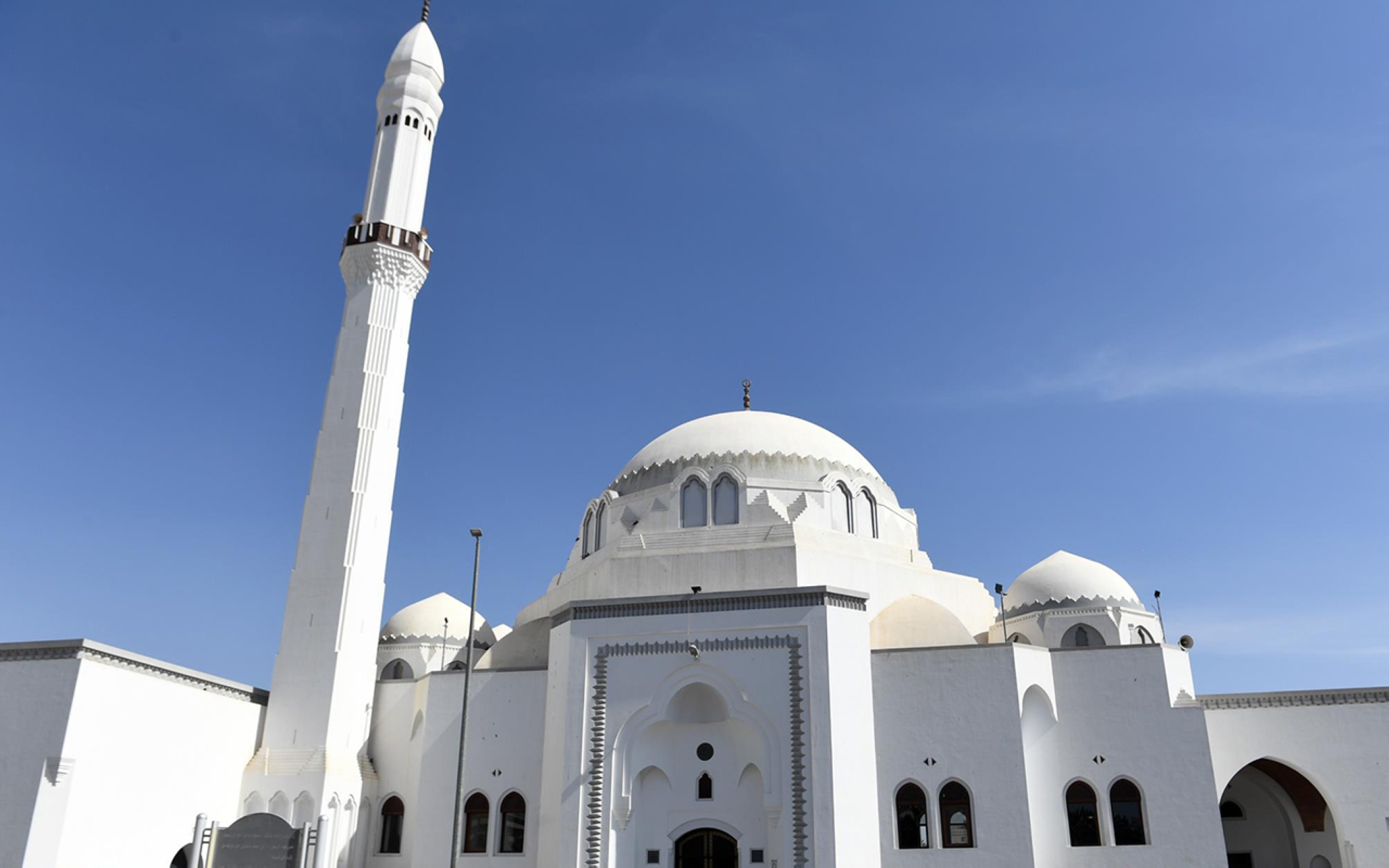
Al-Jumuah Mosque
The historical al-Jumuah Mosque is located in the southwest of al-Madinah al-Munawwarah, approximately nine hundred m north of Quba Mosque. It is also known as al-Wadi Mosque, al-Qubayb Mosque, and Aetikah Mosque. This mosque is closely associated with an event from Islamic history when the Prophet Muhammed (PBUH) prayed the first Jumuah prayer in al-Madinah al-Munawwarah. As the Prophet (PBUH) was on his way to al-Madinah al-Munawwarah after the migration, he stopped at the village of Quba, which was situated about two to three mi away from al-Madinah al-Munawwarah at the time. While he was in route, it was time for the Jummah prayer, so he prayed in the location in the valley of Ranunaa, where the mosque was later built and named al-Jummah Mosque. The mosque was built of stone and has been renovated several times. During the reign of King Fahd Bin Abdulaziz Al Saud, it was rebuilt and expanded, opening in 1991, with a capacity to accommodate 650 worshipers, a significant increase from its previous capacity of only seventy people.
Ghars Well
Located about 1,500 m northeast of Quba Mosque, Ghars Well is south of the Prophet's Mosque. It is one of the historical landmarks associated with Islamic history, having been excavated more than fifteen centuries ago. It is made of basalt stones commonly found in al-Madinah al-Munawwarah. The well has been rehabilitated and restored, along with several other archaeological sites, to welcome visitors. Water has been pumped from the well to provide for those who come to see it, and it has been enclosed with iron barriers for protection. Around the well, there is a space covered with natural rocks. The site also includes an adjacent historic prayer area.
Quba Castle
Quba Castle is one of the famous castles located on the outskirts of al-Madinah al-Munawwarah, and it is a historical landmark situated near Quba Mosque. It was constructed in 1915 for the purpose of monitoring, protecting, and supervising the southern direction. The fort covers an area of approximately 218 m² and consists of a ground floor with two additional stories and a roof. It has one entrance door located on the northern side, and above the door is the main entrance tower.
The castle was built using solid black volcanic stones and was plastered al-Nourah al-Madiniah (a white powder used for wall coating) and gypsum. The General Authority for Tourism and Antiquities at that time was responsible for implementing the restoration project of the castle as part of its efforts to preserve historical and archaeological sites in al-Madinah al-Munawwarah. The restoration work included rehabilitating the foundations, treating the soil and stone walls, reinforcing the wooden ceilings and stone arches, and repairing any cracks.
Related quizzes
Related articles

